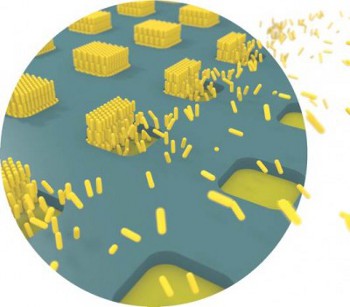More effective monitoring of pollution levels in the workplace is on the horizon following the development of a new construction method for microscopic structures made of gold.
 Researchers found the use of the bottom-up method gave them a new degree of freedom to control the placement of the nanoparticles.
Researchers found the use of the bottom-up method gave them a new degree of freedom to control the placement of the nanoparticles.
The unit of measure for nanostructures, a nanometre, is a billionth of a metre or about 1/50,000 the width of a typical human hair. Materials, including gold, engineered on this tiny scale have vastly different chemical and physical properties to those manufactured on a larger scale.
Monash University’s Associate Professor Udo Bach, his team from the Department of Materials Engineering and collaborators from CSIRO and the Australian Synchrotron have used an unconventional bottom-up strategy to fabricate nanostructures with gold nanoparticles.
The result is gold nanostructures with superior abilities that can be built into monitoring equipment to sense the presence of chemical and biological pollutants. They are 36 times more sensitive than current commercial sensing substrates. The gold nanostructures also have the ability to absorb light, which opens the way for improved absorption of solar energy into solar cells.
Two main strategies are used to fabricate nanostructures. Top-down is a conventional fabrication method where a bulk material is crafted to obtain smaller features, while the bottom-up method starts with nanoparticles to build a larger structure.
The researchers found the use of the bottom-up method gave them a new degree of freedom to control the placement of the nanoparticles.
“To exploit the full potential of novel materials, techniques need to be developed that allow us to integrate them into everyday devices such as solar panels and pollution monitoring equipment,” Associate Professor Bach said.
“Two levels of control are critical for such techniques: the ability to integrate nanoparticles into existing structures and the ability to control the orientation of these nanometre-sized building blocks to form ordered arrays.”
Lead author and PhD candidate Thibaut Thai from the Department of Materials Engineering said the bottom-up method was like building with Lego…at the nanoscale.
“Tiny blocks of gold were joined together until the final structure was reached. Controlling the orientation of the nanorods allowed us to build more complex nanostructures,” Mr Thai said.
“By developing a way to control the assembly of the nanoparticles on surfaces, we were able to reduce the problem of integrating these nanostructures into functional applications.”
Associate Professor Bach said the use of these new arrays of nanoparticles would not be limited to sensor applications. The research team was now focusing on developing their properties in photonic circuits, which ultimately could lead to optical computing applications.
The Melbourne Centre for Nanofabrication and the Australian Synchrotron were both crucial in the success of this project.